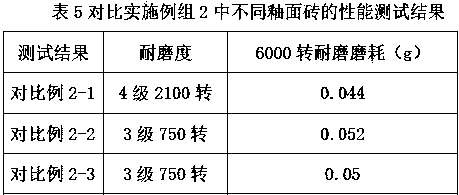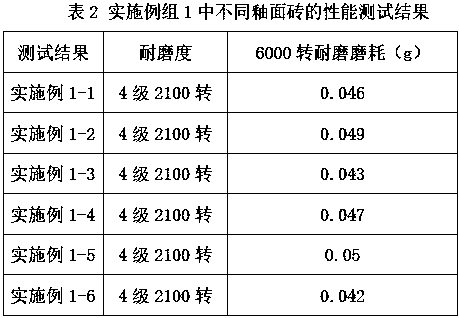Low-temperature wear-resistant frit, wear-resistant glaze using same and glazed tile
A low-temperature, frit technology, applied in the field of architectural ceramics, can solve the problems of not improving the wear resistance of the glaze surface, improving and increasing the active Al2O3 of the frit, etc.
- Summary
- Abstract
- Description
- Claims
- Application Information
AI Technical Summary
Problems solved by technology
Method used
Image
Examples
preparation example Construction
[0055] Embodiment group 1-a kind of preparation method of glazed tile, comprises the following steps:
[0056] Preparation of low temperature wear-resistant frit:
[0057] A. Prepare frit powder with the raw materials in the following table 1 according to the percentage by weight, and heat it for 30 minutes at a melting temperature of 1520° C., then discharge the material and cool it with water to make frit;
[0058] B. Powder and sieve the prepared frit.
[0059] To prepare glazed tiles:
[0060] (1) Put the wear-resistant glaze raw materials into the ball mill to obtain the wear-resistant glaze; wherein, according to the mass percentage, the wear-resistant glaze includes the following raw material components: 15% dolomite, 30% calcined talc, low-temperature wear-resistant frit 27%, calcined zinc oxide 3%, kaolin 10% and calcined kaolin 15%;
[0061] (2) Apply the bottom glaze on the conventional ceramic tile body; wherein, the bottom glaze can be prepared from the formula...
PUM
| Property | Measurement | Unit |
|---|---|---|
| decomposition temperature | aaaaa | aaaaa |
| melting point | aaaaa | aaaaa |
Abstract
Description
Claims
Application Information
 Login to View More
Login to View More - R&D
- Intellectual Property
- Life Sciences
- Materials
- Tech Scout
- Unparalleled Data Quality
- Higher Quality Content
- 60% Fewer Hallucinations
Browse by: Latest US Patents, China's latest patents, Technical Efficacy Thesaurus, Application Domain, Technology Topic, Popular Technical Reports.
© 2025 PatSnap. All rights reserved.Legal|Privacy policy|Modern Slavery Act Transparency Statement|Sitemap|About US| Contact US: help@patsnap.com



